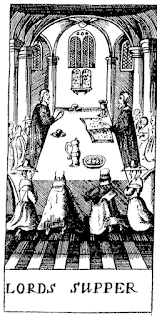'Not a sign, figure, or remembrance only': An Episcopalian Conformist, the Eucharist, and the 1559 French Confession
To apply this to our case; the Church Catholick hath ever held a true fruition of the true Body of Christ in the Eucharist, and not of a signe, figure, or remembrance onely, but as the French confession, que par la vertue secrete & incomprehensible de son Esprit, il nous nourrit & vivifie de la substance de son corps & de son sang [that by the secret and incomprehensible power of his Spirit he feeds and strengthens us with the substance of his body and of his blood]
Twysden was a firm Episcopalian who opposed Parliament's assaults on the Church during the early 1640s, and was a committed Royalist during the civil wars. He helped draft the 1642 Kentish petition which supported the liturgy and episcopacy. An excellent recent study of Twysden's piety notes that he accepted Laudian reforms in the parish church (the Holy Table moved altar-wise and the introduction of rails) and was not associated with local opposition to these changes. This does not necessarily mean that Twysden should be classified as a 'Laudian': as the study notes, there is an absence of evidence beyond his acceptance of Laudian reforms in his parish church. What we can say is that he was a 'sober, peaceable, and truly conscientious Son of the Church of England'. He was, in other words, representative of the lay Episcopalian mainstream of the Interregnum and Restoration: a "lay Anglican piety" committed to Prayer Book and episcopacy, willing to accept Laudian reforms, suspicious and resentful of doctrinal disputes.
It is this which makes Twysden's invocation of the 1559 French Confession significant. Episcopacy, Prayer Book, acceptance of altar rails, and a disdain of doctrinal disputes and speculation (a view shared by Laudians regarding the predestination controversies) cohered with and found expression in a Eucharistic doctrine shared with the Reformed churches across the seas. We might also note that Twysden's wording - "a true fruition of the true Body of Christ in the Eucharist" - is deeply Hookerian:
The fruite of the Eucharist is the participation of the bodie and blood of Christ ... our participation also in the fruit grace and efficacie of his bodie and blood (LEP V.67.6 & 11).
Likewise, Twysden's insistence that Reformed eucharistic doctrine does not make of the Sacrament "a signe, figure, or remembrance onely" clearly echoes Hooker's rejection of any notion that Reformed teaching left the Sacrament "a bare signe or figure onlie" (V.67.8). Twsyden, in other words, was giving expression to the established eucharistic theology of the Elizabethan Settlement: that of Jewel and Hooker, embodied in the BCP, broadly defined by Article 28, a eucharistic theology shared with the continental Reformed tradition.
Two points flow from this. Firstly, and crucially, this was also Laud's eucharistic theology. More broadly, it was the view held by those described as Laudians, not the least of which was Jeremy Taylor. This is a significant reminder of the theological consensus within the Jacobean and Caroline Church of England. Whatever the debates surrounding both theology and ceremonies, there was a Reformed eucharistic consensus (and, we should note, a consensus on many other issues also).
Secondly, Twsyden also represents a much longer consensus on eucharistic teaching within the Church of England, a consensus stretching from the Elizabethan Church to the 1830s. There was a remarkable consistency and stability to the eucharistic theology of the Church of England over these centuries. Yes, there were challenges to it in the early 18th century from both Hoadlian memorialism and Non-jurors, but the overwhelming mainstream remained committed to the view expressed by Twysden in 1658.
Which brings me to the illustration accompanying this post. It is of a 1660 woodcut of the administration of the holy Sacrament in what appears to be a Jacobean parish context. Drew Keane has a fantastic article exploring some of the complexities of the woodcut. I have included the woodcut in this post precisely because, to contemporary Anglican eyes, it is so clearly (and, no doubt to some, horribly) Reformed. A different ordering of the Holy Table, promoted by Laud and widely accepted, without controversy, in the aftermath of the Restoration, did not represent a move away from the Reformed eucharistic understanding seen in the woodcut. This is the eucharistic theology of the Church of England from 1559 to 1833, the eucharistic theology held and confessed by Laud and the High Church tradition, and those "sober, peaceable, and truly conscientious Sons of the Church of England", like Sir Roger Twysden, who accepted altar rails and the Holy Table positioned altar-wise.




Comments
Post a Comment